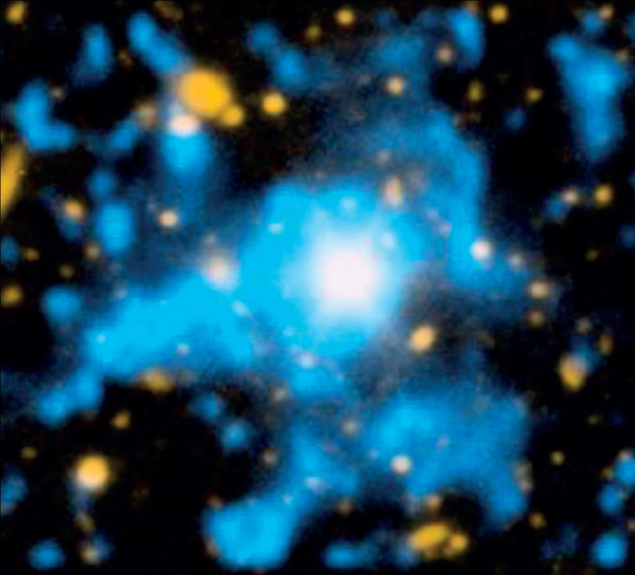
Image credit: Christopher Martin, Robert Hurt.
A team of US astronomers has taken unprecedented images of the intergalactic medium (IGM) – the diffuse gas that connects galaxies throughout the universe. These first pictures of the IGM were obtained with the Cosmic Web Imager (CWI), an instrument designed and built at the California Institute of Technology (Caltech). It opens the way for a deeper understanding of how galaxies form via accretion of gas from the IGM.
Since the late 1980s and early 1990s, theoreticians have predicted that primordial gas from the Big Bang is not spread uniformly throughout space, but is instead distributed in channels that span galaxies and flow between them. This “cosmic web” is a network of filaments crisscrossing one another over the vastness of space and back through time, to an era when galaxies were first forming and stars were being produced at a rapid rate. The visualization of this sponge-like structure of dark matter and gas has become familiar with the advent of numerical simulations of structure formation (CERN Courier September 2007 p11). However, actual observation of this filamentary structure is very difficult. It is only recently that a filament of dark matter was found between two clusters of galaxies (CERN Courier September 2012 p14). Detecting much smaller filaments feeding early galaxies is another challenge.
The usual way to probe the IGM is to look for Lyman-α absorption in the spectrum of a distant quasar. A series of hydrogen clouds along the line of sight to the quasar will produce distinct absorption lines at wavelengths corresponding to the redshift – a measure of the cosmic distance – of each cloud. However, analysis of this “Lyman-α forest” of quasar absorption lines probes the gas distribution in only one direction, so it is not possible to use this method to infer the spatial distribution of the gas clouds.
To overcome this limitation, Christopher Martin at Caltech conceived and developed the CWI. This novel instrument has been designed to detect faint Lyman-α emission from extended regions with redshifts between 1.5 and 4. It is an integral-field spectrograph mounted on the 200 inch (5.1 m) Hale Telescope at the Palomar Observatory. The instrument takes pictures at many different wavelengths simultaneously, yielding a data cube with the image of a small portion of the sky on one side and high-resolution spectroscopic information along the third axis. The data cube can then be sliced to search for spatial structures emitting a narrow, redshifted Lyman-α line.
The first results from the CWI have now been published in two articles. A first paper describes the observation of a narrow filament of gas flowing towards the quasar QSO 1549+19. The ultraviolet emission of the quasar photo-ionizes the gas and therefore induces the observed Lyman-α emission. The filament is about one-million light-years long and its infall motion is suggested by the progressive increase of the velocity dispersion of the gas towards the quasar. Another target was a Lyman-α emission cloud, found to be surrounded by three filaments of gas that are probably feeding a protogalactic disc with a size about three times that of the Milky Way.
Both objects observed by the CWI date to approximately two-thousand-million years after the Big Bang, a time of rapid star formation in galaxies. They have been chosen because of unusually bright Lyman-α emission. To observe the average intergalactic medium everywhere, Martin’s group is now developing the Keck Cosmic Web Imager (KCWI) – a more sensitive and versatile version of the CWI – for use at the Keck Observatory on top of Mauna Kea in Hawaii.








